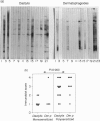Abstract
Atopy is heterogeneous and the IgE immune response of patients allergic to a single allergen (monosensitized) differs from that of those allergic to multiple allergens (polysensitized). Since interleukin-4 (IL-4) and interferon-gamma (IFN-gamma) regulate human IgE synthesis in vitro, we determined whether cytokines may be involved in the heterogeneity of atopy by comparing the serum IgE and sCD23 titres to the cytokine profile of T lymphocytes from 44 atopic patients (13 mono- and 31 polysensitized) and seven non-atopic subjects. Monosensitized patients were allergic to grass or cypress pollens or house dust mites, and polysensitized ones to many pollen species (n = 5) or many allergens (n = 26). Total serum IgE was lower in the control group than in both atopic groups and in the monosensitized group than in the polysensitized one. IgE immunoblots to orchard grass pollen and house dust mites were less heterogeneous in the monosensitized group than in the polysensitized one. IL-4 production by in vitro-activated peripheral blood mononuclear cells (PBMC) was significantly higher in the polysensitized group than in the monosensitized, and marginal in the control group. In contrast, IFN-gamma production was strongly reduced in both atopic groups, and IL-2 production comparable in the three groups. IgE and soluble CD23 (sCD23) release was higher in the atopic groups than in the control, and higher in the polysensitized group than in the monosensitized one. This study shows that PBMC of mono- and polysensitized subjects have a different IL-4 and sCD23 profile and suggests that human beings may be classified into high and low IgE responders on the basis of IL-4 production.
Full text
PDF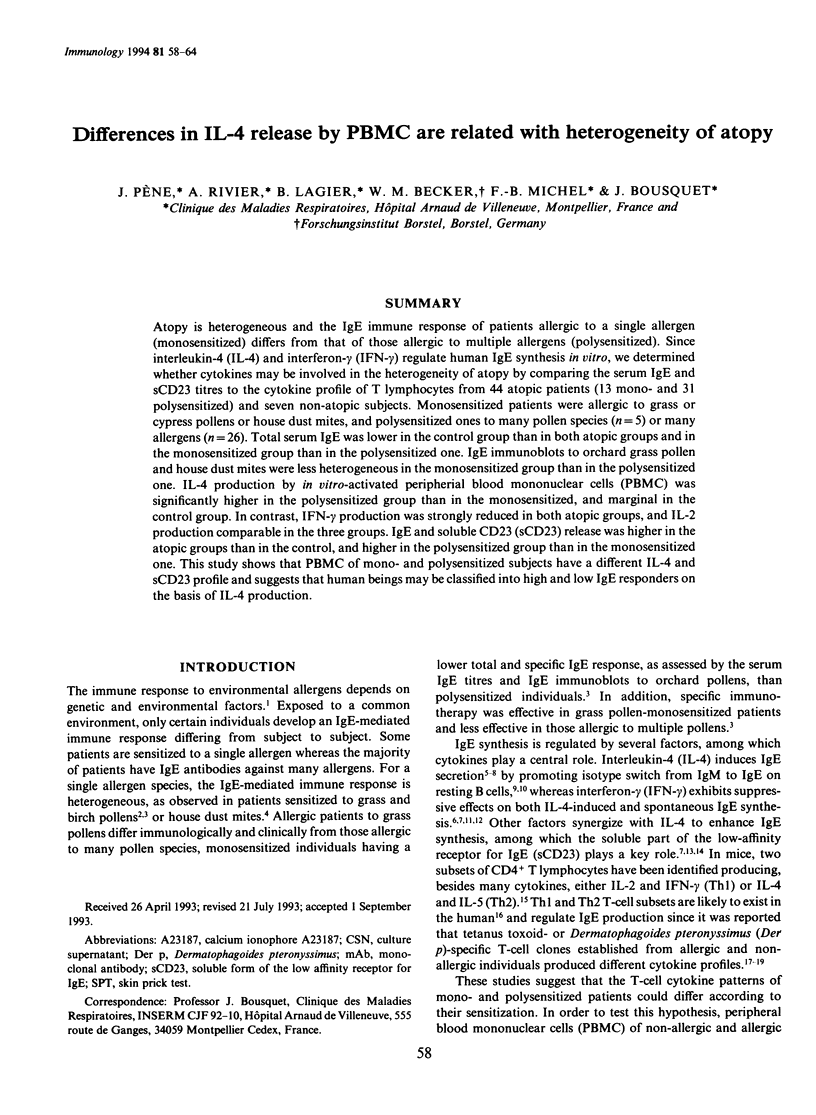
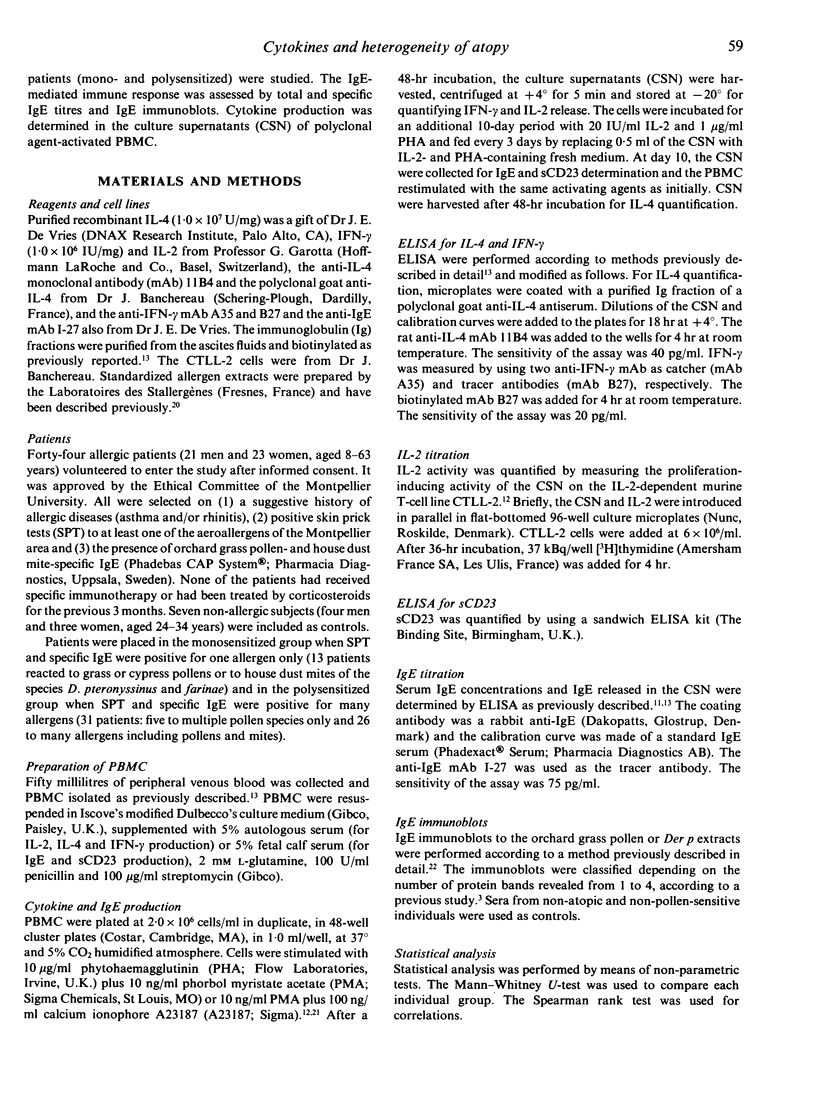
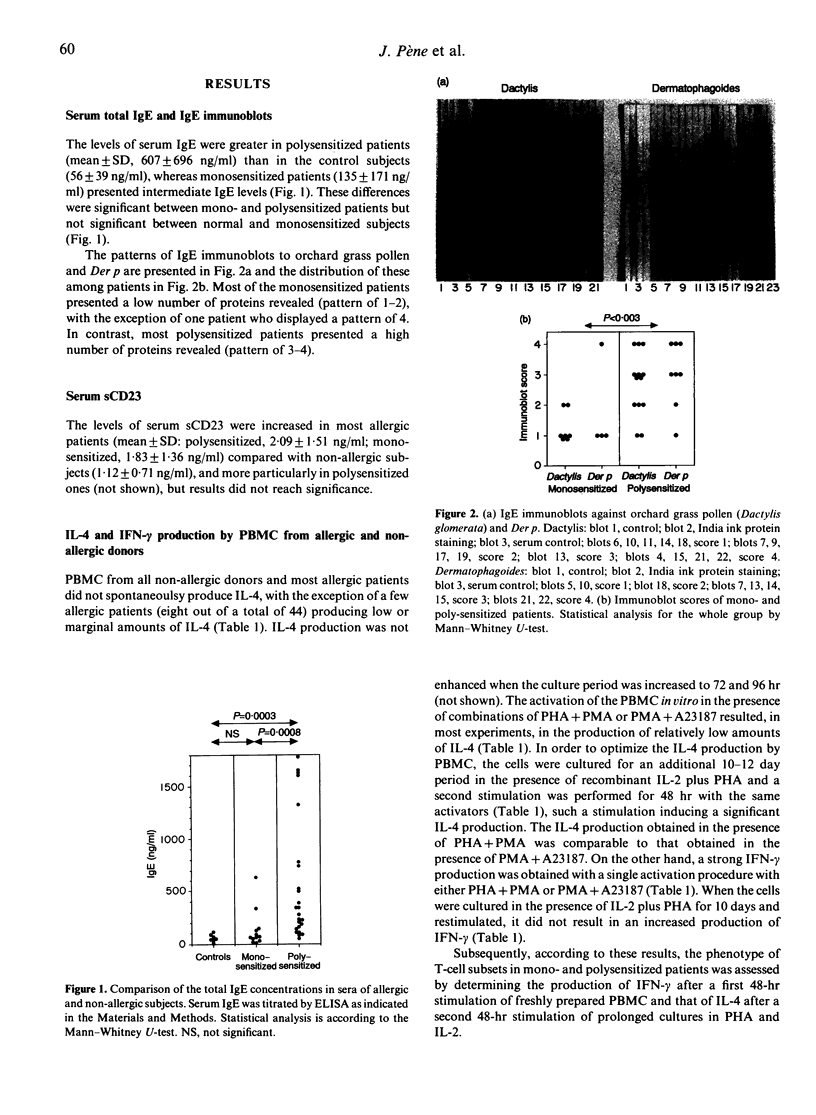
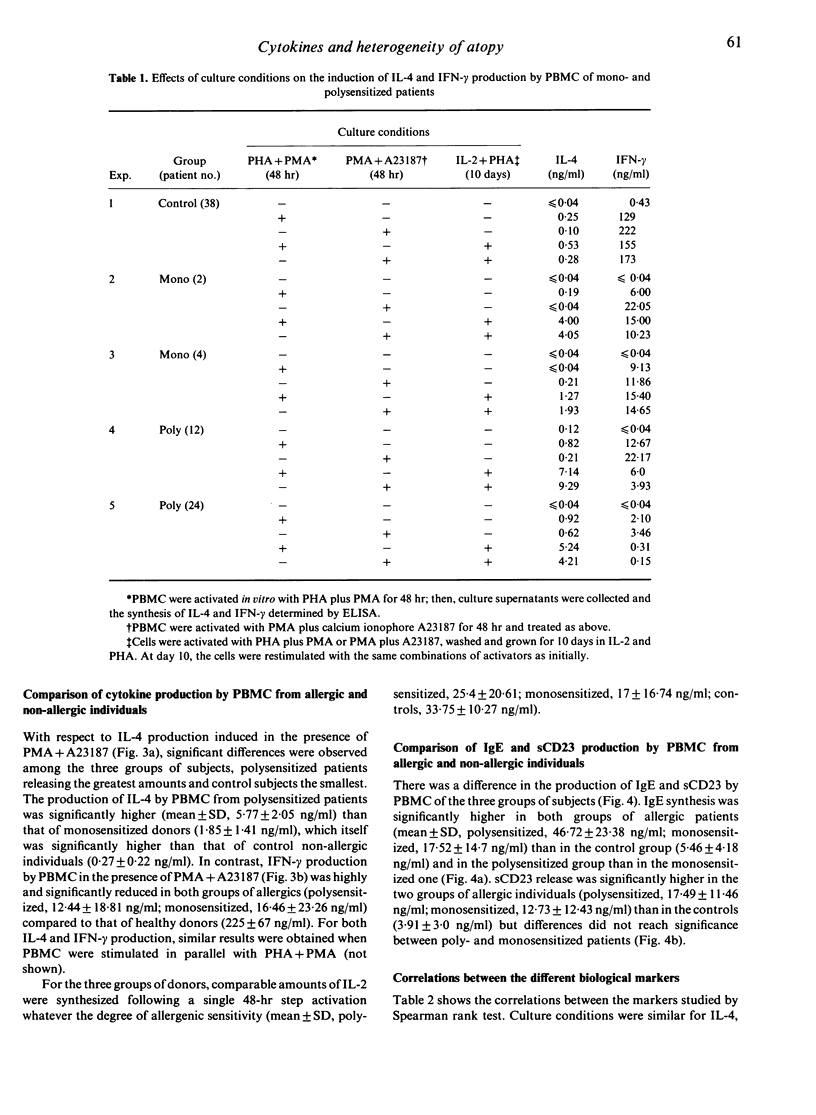

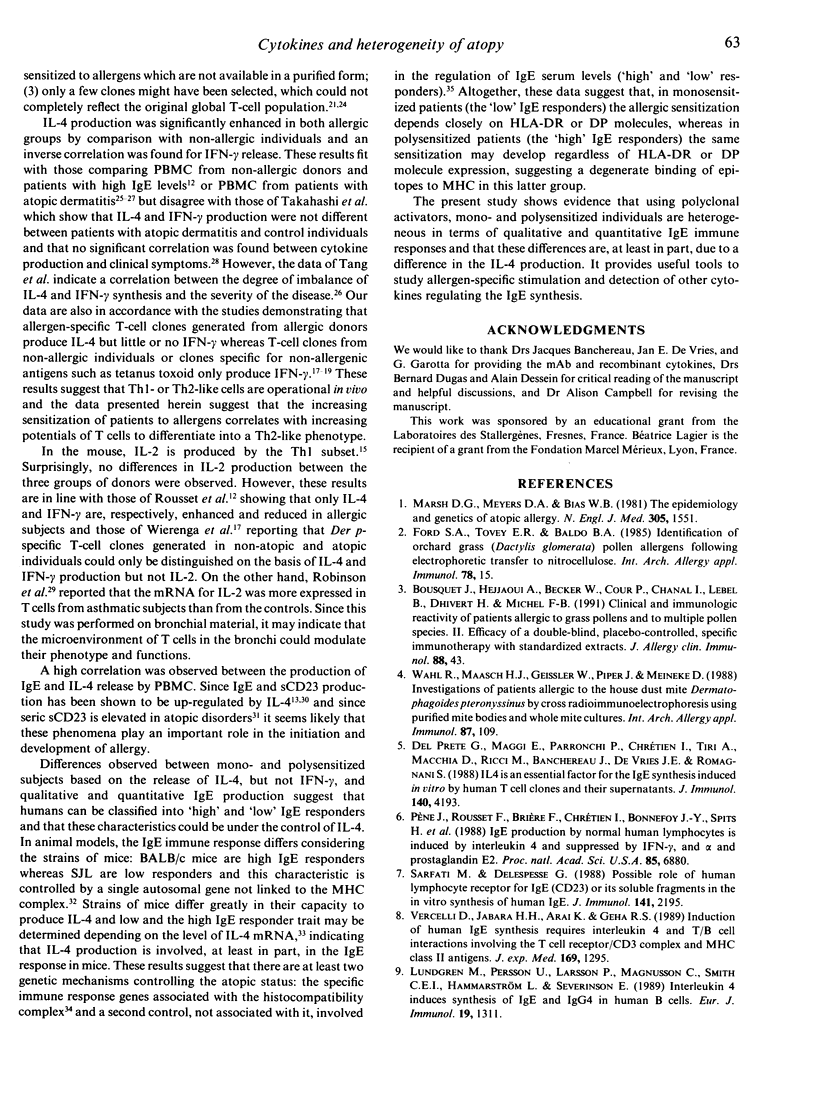
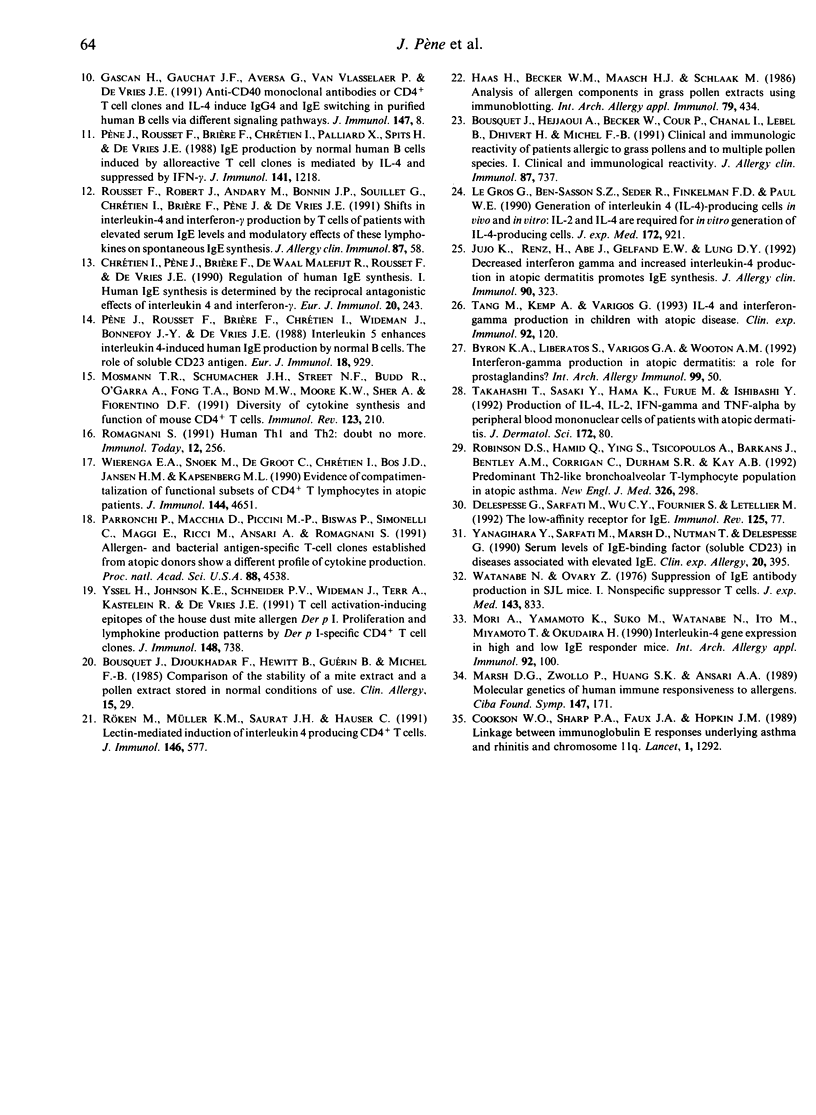
Images in this article
Selected References
These references are in PubMed. This may not be the complete list of references from this article.
- Bousquet J., Becker W. M., Hejjaoui A., Chanal I., Lebel B., Dhivert H., Michel F. B. Differences in clinical and immunologic reactivity of patients allergic to grass pollens and to multiple-pollen species. II. Efficacy of a double-blind, placebo-controlled, specific immunotherapy with standardized extracts. J Allergy Clin Immunol. 1991 Jul;88(1):43–53. doi: 10.1016/0091-6749(91)90299-4. [DOI] [PubMed] [Google Scholar]
- Bousquet J., Djoukadar F., Hewitt B., Guerin B., Michel F. B. Comparison of the stability of a mite and a pollen extract stored in normal conditions of use. Clin Allergy. 1985 Jan;15(1):29–35. doi: 10.1111/j.1365-2222.1985.tb02251.x. [DOI] [PubMed] [Google Scholar]
- Bousquet J., Hejjaoui A., Becker W. M., Cour P., Chanal I., Lebel B., Dhivert H., Michel F. B. Clinical and immunologic reactivity of patients allergic to grass pollens and to multiple pollen species. I. Clinical and immunologic characteristics. J Allergy Clin Immunol. 1991 Mar;87(3):737–746. doi: 10.1016/0091-6749(91)90397-7. [DOI] [PubMed] [Google Scholar]
- Chrétien I., Pène J., Brière F., De Waal Malefijt R., Rousset F., De Vries J. E. Regulation of human IgE synthesis. I. Human IgE synthesis in vitro is determined by the reciprocal antagonistic effects of interleukin 4 and interferon-gamma. Eur J Immunol. 1990 Feb;20(2):243–251. doi: 10.1002/eji.1830200203. [DOI] [PubMed] [Google Scholar]
- Cookson W. O., Sharp P. A., Faux J. A., Hopkin J. M. Linkage between immunoglobulin E responses underlying asthma and rhinitis and chromosome 11q. Lancet. 1989 Jun 10;1(8650):1292–1295. doi: 10.1016/s0140-6736(89)92687-1. [DOI] [PubMed] [Google Scholar]
- Del Prete G., Maggi E., Parronchi P., Chrétien I., Tiri A., Macchia D., Ricci M., Banchereau J., De Vries J., Romagnani S. IL-4 is an essential factor for the IgE synthesis induced in vitro by human T cell clones and their supernatants. J Immunol. 1988 Jun 15;140(12):4193–4198. [PubMed] [Google Scholar]
- Delespesse G., Sarfati M., Wu C. Y., Fournier S., Letellier M. The low-affinity receptor for IgE. Immunol Rev. 1992 Feb;125:77–97. doi: 10.1111/j.1600-065x.1992.tb00626.x. [DOI] [PubMed] [Google Scholar]
- Ford S. A., Tovey E. R., Baldo B. A. Identification of orchard grass (Dactylis glomerata) pollen allergens following electrophoretic transfer to nitrocellulose. Int Arch Allergy Appl Immunol. 1985;78(1):15–21. doi: 10.1159/000233855. [DOI] [PubMed] [Google Scholar]
- Gascan H., Gauchat J. F., Aversa G., Van Vlasselaer P., de Vries J. E. Anti-CD40 monoclonal antibodies or CD4+ T cell clones and IL-4 induce IgG4 and IgE switching in purified human B cells via different signaling pathways. J Immunol. 1991 Jul 1;147(1):8–13. [PubMed] [Google Scholar]
- Haas H., Becker W. M., Maasch H. J., Schlaak M. Analysis of allergen components in grass pollen extracts using immunoblotting. Int Arch Allergy Appl Immunol. 1986;79(4):434–440. doi: 10.1159/000234014. [DOI] [PubMed] [Google Scholar]
- Jujo K., Renz H., Abe J., Gelfand E. W., Leung D. Y. Decreased interferon gamma and increased interleukin-4 production in atopic dermatitis promotes IgE synthesis. J Allergy Clin Immunol. 1992 Sep;90(3 Pt 1):323–331. doi: 10.1016/s0091-6749(05)80010-7. [DOI] [PubMed] [Google Scholar]
- Le Gros G., Ben-Sasson S. Z., Seder R., Finkelman F. D., Paul W. E. Generation of interleukin 4 (IL-4)-producing cells in vivo and in vitro: IL-2 and IL-4 are required for in vitro generation of IL-4-producing cells. J Exp Med. 1990 Sep 1;172(3):921–929. doi: 10.1084/jem.172.3.921. [DOI] [PMC free article] [PubMed] [Google Scholar]
- Marsh D. G., Meyers D. A., Bias W. B. The epidemiology and genetics of atopic allergy. N Engl J Med. 1981 Dec 24;305(26):1551–1559. doi: 10.1056/NEJM198112243052603. [DOI] [PubMed] [Google Scholar]
- Marsh D. G., Zwollo P., Huang S. K., Ansari A. A. Molecular genetics of human immune responsiveness to allergens. Ciba Found Symp. 1989;147:171–187. doi: 10.1002/9780470513866.ch11. [DOI] [PubMed] [Google Scholar]
- Mori A., Yamamoto K., Suko M., Watanabe N., Ito M., Miyamoto T., Okudaira H. Interleukin-4 gene expression in high and low IgE responder mice. Int Arch Allergy Appl Immunol. 1990;92(1):100–102. doi: 10.1159/000235233. [DOI] [PubMed] [Google Scholar]
- Parronchi P., Macchia D., Piccinni M. P., Biswas P., Simonelli C., Maggi E., Ricci M., Ansari A. A., Romagnani S. Allergen- and bacterial antigen-specific T-cell clones established from atopic donors show a different profile of cytokine production. Proc Natl Acad Sci U S A. 1991 May 15;88(10):4538–4542. doi: 10.1073/pnas.88.10.4538. [DOI] [PMC free article] [PubMed] [Google Scholar]
- Pène J., Rousset F., Brière F., Chrétien I., Bonnefoy J. Y., Spits H., Yokota T., Arai N., Arai K., Banchereau J. IgE production by normal human lymphocytes is induced by interleukin 4 and suppressed by interferons gamma and alpha and prostaglandin E2. Proc Natl Acad Sci U S A. 1988 Sep;85(18):6880–6884. doi: 10.1073/pnas.85.18.6880. [DOI] [PMC free article] [PubMed] [Google Scholar]
- Pène J., Rousset F., Brière F., Chrétien I., Paliard X., Banchereau J., Spits H., De Vries J. E. IgE production by normal human B cells induced by alloreactive T cell clones is mediated by IL-4 and suppressed by IFN-gamma. J Immunol. 1988 Aug 15;141(4):1218–1224. [PubMed] [Google Scholar]
- Pène J., Rousset F., Brière F., Chrétien I., Wideman J., Bonnefoy J. Y., De Vries J. E. Interleukin 5 enhances interleukin 4-induced IgE production by normal human B cells. The role of soluble CD23 antigen. Eur J Immunol. 1988 Jun;18(6):929–935. doi: 10.1002/eji.1830180615. [DOI] [PubMed] [Google Scholar]
- Robinson D. S., Hamid Q., Ying S., Tsicopoulos A., Barkans J., Bentley A. M., Corrigan C., Durham S. R., Kay A. B. Predominant TH2-like bronchoalveolar T-lymphocyte population in atopic asthma. N Engl J Med. 1992 Jan 30;326(5):298–304. doi: 10.1056/NEJM199201303260504. [DOI] [PubMed] [Google Scholar]
- Romagnani S. Human TH1 and TH2 subsets: doubt no more. Immunol Today. 1991 Aug;12(8):256–257. doi: 10.1016/0167-5699(91)90120-I. [DOI] [PubMed] [Google Scholar]
- Röcken M., Müller K. M., Saurat J. H., Hauser C. Lectin-mediated induction of IL-4-producing CD4+ T cells. J Immunol. 1991 Jan 15;146(2):577–584. [PubMed] [Google Scholar]
- Sarfati M., Delespesse G. Possible role of human lymphocyte receptor for IgE (CD23) or its soluble fragments in the in vitro synthesis of human IgE. J Immunol. 1988 Oct 1;141(7):2195–2199. [PubMed] [Google Scholar]
- Tang M., Kemp A., Varigos G. IL-4 and interferon-gamma production in children with atopic disease. Clin Exp Immunol. 1993 Apr;92(1):120–124. doi: 10.1111/j.1365-2249.1993.tb05957.x. [DOI] [PMC free article] [PubMed] [Google Scholar]
- Vercelli D., Jabara H. H., Arai K., Geha R. S. Induction of human IgE synthesis requires interleukin 4 and T/B cell interactions involving the T cell receptor/CD3 complex and MHC class II antigens. J Exp Med. 1989 Apr 1;169(4):1295–1307. doi: 10.1084/jem.169.4.1295. [DOI] [PMC free article] [PubMed] [Google Scholar]
- Wahl R., Maasch H. J., Geissler W., Piper J., Meineke D. Investigations of patients allergic to the house dust mite Dermatophagoides pteronyssinus by crossed radioimmunoelectrophoresis using purified mite bodies and whole mite culture extracts. Int Arch Allergy Appl Immunol. 1988;87(1):109–112. doi: 10.1159/000234659. [DOI] [PubMed] [Google Scholar]
- Watanabe N., Kojima S., Ovary Z. Suppression of IgE antibody production in SJL mice. I. Nonspecific suppressor T cells. J Exp Med. 1976 Apr 1;143(4):833–845. doi: 10.1084/jem.143.4.833. [DOI] [PMC free article] [PubMed] [Google Scholar]
- Wierenga E. A., Snoek M., de Groot C., Chrétien I., Bos J. D., Jansen H. M., Kapsenberg M. L. Evidence for compartmentalization of functional subsets of CD2+ T lymphocytes in atopic patients. J Immunol. 1990 Jun 15;144(12):4651–4656. [PubMed] [Google Scholar]
- Yanagihara Y., Sarfati M., Marsh D., Nutman T., Delespesse G. Serum levels of IgE-binding factor (soluble CD23) in diseases associated with elevated IgE. Clin Exp Allergy. 1990 Jul;20(4):395–401. doi: 10.1111/j.1365-2222.1990.tb02800.x. [DOI] [PubMed] [Google Scholar]
- Yssel H., Johnson K. E., Schneider P. V., Wideman J., Terr A., Kastelein R., De Vries J. E. T cell activation-inducing epitopes of the house dust mite allergen Der p I. Proliferation and lymphokine production patterns by Der p I-specific CD4+ T cell clones. J Immunol. 1992 Feb 1;148(3):738–745. [PubMed] [Google Scholar]



